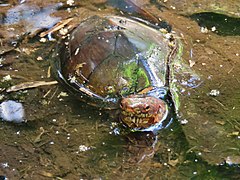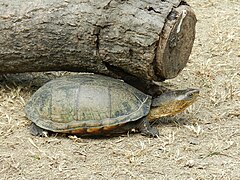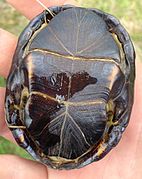
The Kinosternidae are a family of mostly small turtles that includes the mud turtles and musk turtles. The family contains 25 species within four genera, but taxonomic reclassification is an ongoing process, so many sources vary on the exact numbers of species and subspecies. They inhabit slow-moving bodies of water, often with soft, muddy bottoms and abundant vegetation.

Trachemys is a genus of turtles belonging to the family Emydidae. Members of this genus are native to the Americas, ranging from the Midwestern United States south to northern Argentina, but one subspecies, the red-eared slider, has been introduced worldwide. Species under this genus are commonly referred to as sliders.

Cyclanorbis is a genus of softshell turtles in the family Trionychidae. The genus is endemic to Africa.

Acanthochelys is a genus of turtles, the spiny swamp turtles, in the family Chelidae, subfamily Chelinae, found in South America. Until recently, the species of this genus were considered to be members of the genus Platemys, but were moved to the resurrected genus originally described by Gray (1873) based on the type species by monotypy Acanthochelys spixii.
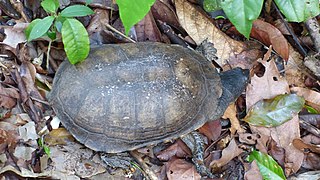
The Brazilian radiolated swamp turtle is a species of turtle in the Chelidae family endemic to Brazil.
Dunn's mud turtle, also known commonly as the Colombian mud turtle, is a species of turtle in the family Kinosternidae.

The Oaxaca mud turtle is a species of mud turtle in the family Kinosternidae. It is endemic to Mexico. Both the common name and the scientific name derive from Oaxaca, a Mexican state. The International Union for Conservation of Nature has rated this species as "data deficient" as there is insufficient information available to judge its conservation status.

Sometimes called the bearded toadheads but better known by their scientific name of Phrynops this genus of turtles has often been a bit of a dumping ground for the short-necked South American turtles of the family Chelidae.
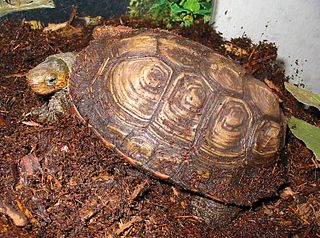
Rhinoclemmys is a genus of turtles in the family Geoemydidae, the only genus in the subfamily Rhinoclemmydinae. Member species of the genus are commonly known as the Neotropical wood turtles and are the only geoemydids known from the Americas. As such, they have adapted to a wide range of habitats, which is reflected in the species' common names.
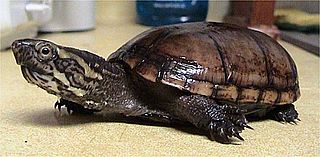
The eastern mud turtle or common mud turtle is a common species of turtle in the family Kinosternidae. The species is endemic to the United States. There are two recognized subspecies.
The Florida mud turtle is a species of turtle in the family Kinosternidae. The species is endemic to the state of Florida in the United States. This species of turtle is extremely rare compared to others.
The Alamos mud turtle is a species of mud turtle in the family Kinosternidae. It is endemic to Mexico, where it occurs in the states of Sinaloa and Sonora.

The Arizona mud turtle is a species of mud turtle in the family Kinosternidae found in the deserts of Arizona and Sonora (Mexico). It is a semi-aquatic turtle. It lives in impermanent puddles, and avoids permanent rivers and lakes.
Kinosternon arizonense is an extinct species of mud turtle in the genus Kinosternon. Initially described by Charles W. Gilmore in 1922. In 2016 McCord examined available Pliocene material of K. arizonense and concluded that the fossil material differs significantly from the extant turtles. Joyce and Bourque (2016) concurred. Rhodin et al. (2017), listed Kinosternon arizonense as extinct.

The rough-footed mud turtle is a species of mud turtle in the family Kinosternidae. The species is endemic to the southwestern United States and northern Mexico.

The white-lipped mud turtle is a species of mud turtle in the family Kinosternidae. The species is endemic to Central America and northwestern South America.

The scorpion mud turtle or Tabasco mud turtle is a species of mud turtle in the family Kinosternidae. It is found in Mexico, Central and South America. It is a medium to large kinosternid with a domed, oval upper shell 92–270 mm (3.6–10.6 in) long. Males regularly exceed 200 mm. The scorpion mud turtle is a highly aquatic, adaptable kinosternid that will live in almost any body of water. It is primarily omnicarnivorous, a glutton, and feeds on a wide variety of aquatic invertebrates and vertebrates, as well as carrion and bird eggshells. It also feeds on plant material such as algae, fruits, flowers, nuts, seeds and aquatic plants. In captivity, poorly fed K. scorpioides can be cannibalistic, biting off the toes and limbs of conspecifics. Females probably lay 1 to 6 hard-shelled eggs. Like many kinosternids, they probably construct a shallow terrestrial nest with little cover.

The Mexican mud turtle, is a species of mud turtle in the family Kinosternidae. Endemic to Mexico, it is found in Aguascalientes, Colima, Durango, Guanajuato, Guerrero, Hidalgo, Jalisco, Michoacán, México, Morelos, Nayarit, Oaxaca, Puebla, Queretaro, San Luis Potosí, Sinaloa, Sonora, Tamaulipas and Zacatecas, where they inhabit moist environments, such as shallow ponds, lakes, rivers or intermediate temp. tropical forest areas.

